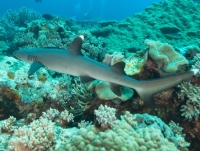Atlantic sharks face extinction due to overfishing and shark-finning
 More than 25 per cent of sharks in the north-east Atlantic are at risk of extinction, a new study warns.
More than 25 per cent of sharks in the north-east Atlantic are at risk of extinction, a new study warns.
Another 20 per cent have been put in the near-threatened category, according to research for the International Union for Conservation of Nature (IUCN).
And the figures may be an underestimate as there is insufficient data to assess more than a quarter – 27 per cent – of species.
The IUCN Shark Specialist Group (SSG) who drew up the report said it should
serve as a dire warning that more needs to be done to protect sharks.
Most of the damage is inflicted by overfishing and by sharks caught as a
by-product either in nets or on long-lines. But sharks are being
increasingly targeted by commercial fishermen for their fins which can fetch
as much as £400 per kilo on the Asian food market.
Because sharks are long-lived and slow to mature they are not prolific
breeders which makes them even more vulnerable to over-exploitation.
Because of their position at the top of the food chain they have a critical
role in maintaining the balance of ocean ecosystems.
The SSG study looked at the 116 species of shark, closely related rays and
chimera (from two different species) in the north-east Atlantic.
It found that 26 per cent are threatened with extinction – much higher than
the comparable global figure of 18 per cent.
Seven per cent are critically endangered, seven per cent are endangered and 22
per cent are vulnerable. A further 20 per cent are near threatened.
Two sharks most at risk – spiny dogfish and porbeagle – are the most sought
after in Europe for their meat. Both are subject to EU fishing quotas that
are well above the zero catch mark recommended by scientists with the
International Council for Exploration of the Sea (ICES).
The spiny dogfish often ends up on the menu bill as Rock Salmon or in fish and
chips and the migratory porbeagle as swordfish. It is also much prized for
its fins.
Claudine Gibson, lead author of the report, said: “From angel sharks to
devil rays, north east Atlantic populations of these vulnerable species are
in serious trouble, more so than in many other parts of the world.
“Most sharks and rays are exceptionally vulnerable to over fishing
because of their tendency to grow slowly, mature late and produce few young.
“Those at greatest risk in the north east Atlantic include heavily fished
large sharks and rays, like porbeagle and common skate, as well as
commercially valuable deep water sharks and spiny dogfish.”
Sonja Fordham, Policy Director for Shark Alliance, a coalition of conservation
and scientific groups, said she had no doubt that some fishing nations were
deliberately targeting sharks because of their value despite claiming they
were being caught only as a by product.
She said only four species – basking shark, great white shark, dogfish and
porbeagle have legal protection under EU law while only the UK and Sweden
provided full protection for certain shark and ray species. Apart from some
agreements between the EU and Norway there are no international catch limits
on north east Atlantic sharks.
But with several important fishing related conferences over the next few
months there is a great opportunity to improve the protection status of
sharks.
“Never before have European countries had more reason or opportunity to
safeguard the beleaguered shark and ray species of the northeast Atlantic,”
she said.
“Country officials should heed the dire warnings of this report and act
to protect threatened sharks and rays at national, regional and
international levels. Such action is immediately possible and absolutely
necessary to change the current course toward extinction of these remarkable
ocean animals.”
The report recommends:
*Improving scientific data on shark species to determine their true
conservation status.
*Scientific advice on catch limits should be heeded.
*Minimising catches through better technology and more selectivity.
*An end to finning by ensuring sharks caught legally are landed with their
fins intact.
Some other threatened species:
Angel sharks and common skate: Classed as critically endangered. ICES
has called for an end to the fishing of common skate and for angel sharks to
be given the highest possible protection.
Gulper shark: Critically endangered. One of se veral deep water species
sought for its rich liver oil that is used in cosmetics. ICES has
recommended a zero catch limit for deep water species.
Sawfish: Two types are listed as critically endangered but may already
be extinct.
Guitarfish: Two species are classified as endangered. They are rays
whose fins are highly prized for use in shark fin soup. There are no
European limits on catches of guitarfish.
Basking shark: Officially described as endangered in the north east
Atlantic. The world’s second largest fish is now protected in EU waters but
remains vulnerable because of the value of its huge liver and fins.
Bigeye thresher: Listed as vulnerable and at the greatest risk of over
fishing by open ocean long line fisheries.
Tope: Data deficient but England and Wales have brought in
precautionary bans on targeted fishing.
Blue shark: The dominant species taken in longline fisheries considered
near threatened. No subject to any EU or international catch limit.
By Paul Eccleston
You can return to the main Market News page, or press the Back button on your browser.

